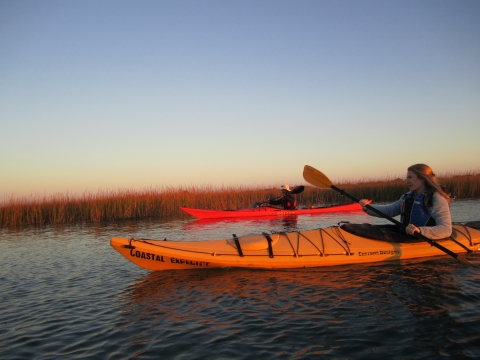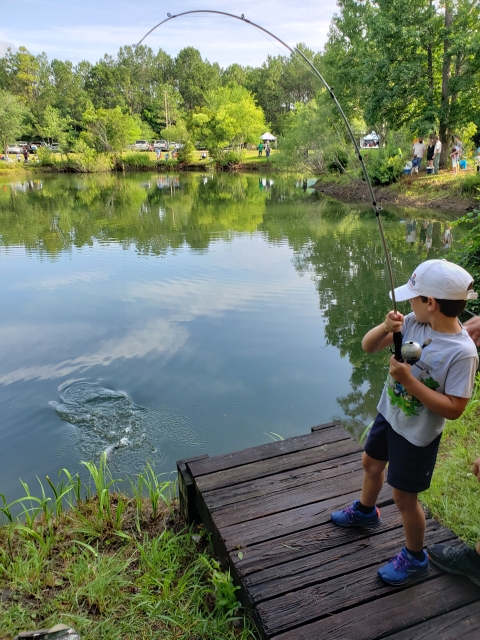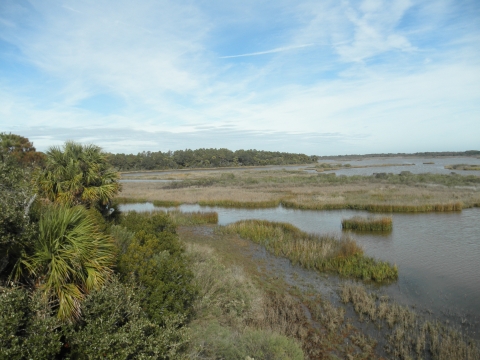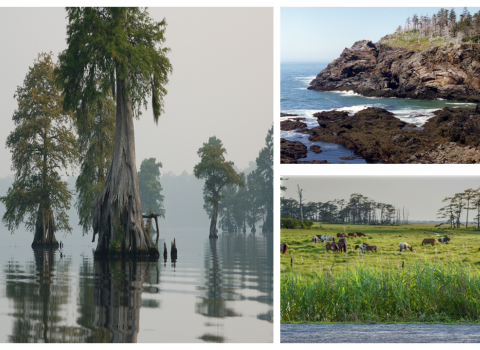We emerge from winter and come out of our seclusion as Covid-19 restrictions soften in 2022. During the pandemic, public lands became our respite as we sought refuge from being stuck indoors. In coastal South Carolina, staff at Cape Romain National Wildlife Refuge (NWR) remember seeing more families at the beach than ever before. National Wildlife Refuge System visitation hit an all-time high of 65 million visits in 2021, an almost 30% increase from 2016. Increasingly, spending time outdoors matters to people for a variety of reasons, including perhaps renewed appreciation of the healing power of nature in the face of the COVID 19 pandemic. The growing demand of outdoor access and services during the pandemic gave rise to the Recreate Responsibly movement to help everyone care for each other and our outdoor places.
As U.S. Fish and Wildlife Service refuges across the nation pivot into spring, we feel a renewed sense of commitment to the public we serve and the quest to recreate responsibly.
We want our communities to continue discovering these incredible places, whether for the first time or rediscovering the places they know. Regardless of background and degrees of experience, we have many ways to engage and keep folks coming for more.
At Cape Romain NWR, people come to fish, beachcomb, walk, swim, or simply relax on the beach and enjoy the landscapes. The lifetime outdoorsmen, the first-time kayaker, and the young budding naturalists all have a place here. Cape Romain NWR extends 22 miles along South Carolina's Atlantic Coast. Over 66,000 acres, this semi-tropical paradise of barrier islands, sandy beaches, salt marsh salt marsh
Salt marshes are found in tidal areas near the coast, where freshwater mixes with saltwater.
Learn more about salt marsh , ocean blue tidal creeks, and pristine wilderness is open every day from sunrise to sunset.
Refuge Ranger, Patricia “Tricia” Midgett, is very familiar with the ebb and flow of the tides, as well as the visitors throughout the seasons. She knows all the vistas and trails and is attune to the myriad of opportunities this refuge has to offer. We asked Tricia to give us a run down of what visitors should know and expect to find at Cape Romain NWR, this spring. We hope you take notes (or print this article and this brochure) and go explore. The refuge relies heavily on their Facebook page to keep folks updated, so make sure to check the page for current information before heading out. This Q&A has been edited for length and clarity.
Q: How can we get to the refuge?
Tricia: The refuge barrier islands and waters are only accessible by boat. When visiting Cape Romain NWR, we recommend that folks plan to spend their day at Bulls Island. Coastal Expeditions is a contracted concessioner and the only outfitter authorized to take visitors on ferry trips to the island, running on Tuesday, Thursday, Friday, and Saturday. Reservations are required. You can find transportation fees and schedules at Coastal Expedition’s website.
Q: Can we enjoy the refuge without catching a ferry ride?
Tricia: Yes! Cape Romain NWR lands and waters encompass water impoundments, creeks and bays, emergent salt marsh and barrier islands. A 29,000 acre wilderness area includes refuge barrier islands only accessible by boat. Visitors with motorized boats and kayaks are welcome to navigate through the estuary during daylight hours. Some islands are closed during bird or turtle nesting seasons. Check for seasonal closures online, before you go.
Visitors without a boat can enjoy fishing and crabbing off the pier at Garris Landing at the end of Bulls Island Road. They may also hike the Nebo trail located adjacent to the Sewee Visitor Environmental Education Center.
Q: The refuge map shows two trails, Beach Road Trail and Turkey Walk Trail. If you had to pick only one trail, which one would it be?
Tricia: I would choose Turkey Walk Trail. The two-mile hike is recognized as a National Recreation Trail National Recreation Trail
A National Recreation Trail is a land-based or water-based trail that provides an outdoor recreation opportunity on federal, state, tribal or local public land. National Recreation Trails were established by the National Trails System Act of 1968 (Public Law 90-543), which authorized creation of a national trails system composed of National Recreation Trails, National Scenic Trails and National Historic Trails. Whereas National Scenic Trails and National Historic Trails may be designated only by an act of Congress, National Recreation Trails may be designated by the Secretary of the Interior or the Secretary of Agriculture to recognize exemplary trails of local and regional significance.
Learn more about National Recreation Trail that takes visitors past the salt marsh areas of the bay, across the dike between the Upper and Lower Summerhouse Ponds - great for bird watching - and through a dense maritime forest that feels like a sub-tropical forest with palmettos, dwarf palmettos, magnolias, hollies, bays, and pines. This portion of the trail leads the visitor out to Beach Road. Beach Road is one of our maintained roads (mostly grass cover) but considered a "trail," as visitors mostly use this road which leads directly to the beach from the public dock on the bay side. People can experience salt marsh, maritime forest and beach areas. Birdwatching is excellent throughout the year. Bulls Island is also the place to see American alligators, white-tailed deer, black fox squirrels and even the elusive bobcat. Two hiking trails and 16 maintained unpaved roads provide access throughout the island.
Q: How’s the fishing?
Tricia: The estuary, Sewee Bay, and creeks have an abundance of fish. Popular fish species during Spring include redfish and black drum, trout, sheepshead and flounder. Surf-fishing off the beaches for spottail bass, sea trout, and flounder is also very popular. If you aren't going out into the estuary, you can fish and crab off Garris Landing pier. Clamming, oystering, crabbing, and shrimping are also popular in the estuaries. For recreational fin fishing and shell fishing, be familiar with state regulations and have all state licenses required. People can keep their catch following South Carolina state fishing regulations.
Q: Is Spring a good time to go birding?
Tricia: The refuge is known as a birder's "hotspot" and rightfully so with over 293 recorded species. Birds capturing mosquitos and other insects to give as gifts to their prospective mates are a common sight. Wading and shorebirds combing the beaches for critters buried in the sand are entertaining to watch. The refuge was established as a sanctuary for wildlife like seabirds and shorebirds. Birding here is good throughout the year, but long distant migrants make spring and fall even more interesting. Birds like the Rufa red knot, one of the longest distance migrants in the animal kingdom, use the refuge as stop-over in the spring (March – May) and fall (August – October) . They use the refuge’s resources, to quickly replenish their body condition and rebuild fat stores for the next leg of their migration. We close certain areas of the beaches on Cape, Bulls, and Lighthouse Island for shorebird and seabird nesting activity. Marsh Island, White banks, Bird Key-Bulls Bay are closed to all public access for bird nesting, roosting, and foraging. The public can visit our Facebook page and the website to obtain information about closures.
Q: The Sewee Center closed during the pandemic. Will there be opportunities to experience marine science education at the refuge?
Tricia: The Friends of Coastal South Carolina educator and volunteers are providing modified outside education programs at local schools and offering virtual education programming. In 2022, we look forward to reopening the Sewee Visitor and Environmental Education Center, before the annual Youth Fishing Rodeo for children scheduled on June 11. We partner with the Francis Marion National Forest for the event. People also come to the visitor center to see the endangered red wolves. Currently, we have 4 red wolves. Once reopened, red wolf presentations occur weekly on Thursday and Saturday. The Sewee Center is located off of Highway 17, so visitors don’t need to catch a ferry to experience it. To find out more, visit https://www.fws.gov/refuge/cape-romain
Q: Loggerhead sea turtles start arriving and nesting in spring. Can the public experience the sea turtle nesting season at Cape Romain?
Tricia: Refuge staff will post turtle activity on the refuge’s Facebook page with photos of volunteers who assist us during the season. For the protection of sea turtles that nest on the refuge, we do not offer recreational trips to visit the islands while sea turtles nest. We welcome individuals and organized groups to help us further our conservation goal. People who are interested in volunteering for the refuge - doing turtle and other work - should email me at patricia_midgett@fws.gov
Q: What are some unique activities coming up?
Tricia: Regularly scheduled outdoor adventures with professional naturalists offer deeper exploration into specific areas on the refuge. Beginning in May, five full moon cruises will be offered over the course of this year. The Lighthouse Tours are very popular with three trips scheduled in 2022: April 3, October 16, and October 30. The Boneyard sunrise trip is a special opportunity to capture spectacular views of the sunrise over the Atlantic Ocean. The experience is offered once or twice a month, and only through Coastal Expeditions. Folks interested in any of these unique opportunities must contact Coastal Expeditions directly at 843.884.7684 or email: info@coastalexpeditions.com to make reservations.
People who have their own boats cannot enter the refuge before sunrise. The refuge is only open from dawn to dusk.
Whether a guided kayak or ferry excursion, beach walk or trail hike, interpretive tour or education in an outdoor classroom, you can explore and experience all the wonderful opportunities on the refuge. Cape Romain National Wildlife Refuge is yours to experience and explore. Come recreate with us! When you re-create, you gain back. Let the vastness of the estuary restore and refresh you. We will continue to administer this network of lands and waters to sustain diverse communities of plants, animals, and people as well. Come for a visit, and please remember to Recreate Responsibly!








